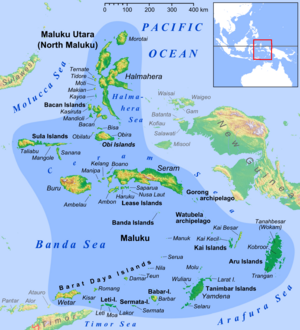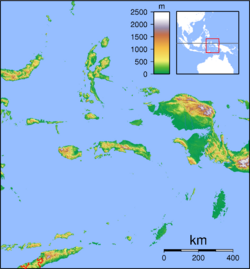Ambon Island facts for kids

Ambon (left) and the Lease Islands
|
|
| Geography | |
|---|---|
| Location | South East Asia |
| Coordinates | 3°38′17″S 128°07′02″E / 3.63806°S 128.11722°E |
| Archipelago | Maluku Islands |
| Area | 743.37 km2 (287.02 sq mi) |
| Highest elevation | 1,225 m (4,019 ft) |
| Highest point | Mount Salahutu |
| Administration | |
|
Indonesia
|
|
| Province | Maluku |
| Largest settlement | Ambon |
| Demographics | |
| Population | 482,806 |
| Pop. density | 649.48 /km2 (1,682.15 /sq mi) |
| Languages | Ambonese |
| Ethnic groups | Ambonese |
| Additional information | |
| Time zone |
|

Ambon Island is a beautiful island in Indonesia, part of the Maluku Islands. It covers about 743 square kilometers (287 square miles). The island is known for its mountains, good water supply, and fertile land.
Ambon Island has two main parts. The southern part is home to the city of Ambon. This city is also the capital of the Maluku province. The northern part of the island has several smaller districts. In mid-2023, about 482,806 people lived on Ambon Island.
The island has an airport. It is also home to several universities, including Pattimura University and Open University.
Contents
Geography
Ambon Island is located near the larger Seram island. It sits on the north side of the Banda Sea. This area is part of a chain of volcanic islands. The island is about 51 kilometers (32 miles) long. It has a very unusual shape because a large inlet, Ambon Bay, almost cuts it in half.
The smaller southeastern part of the island is called Leitimur. It connects to the larger northern part, called Leihitu or Hitoe, by a narrow strip of land. Ambon Bay stretches about 20 kilometers (12 miles) into the island. The airport is on the northern side of the bay. The city of Ambon is located around the bay, with a safe harbor.
The highest mountains on Ambon are Wawani (1,100 meters or 3,600 feet) and Salahutu (1,225 meters or 4,019 feet). These mountains are volcanoes and have hot springs. The mountains on nearby Lease Islands are volcanoes that are no longer active.
Wild parts of Ambon Island are covered by tropical rainforest. This forest is part of the Seram rain forests area. Ambon, Seram, and most of Maluku are part of Wallacea. This is a group of Indonesian islands separated by deep water from both Asia and Australia. Because of this, they have unique plants and animals.
Ambon has few native mammals. However, birds are very common. The island also has many different kinds of insects, especially butterflies. Many beautiful Seashells can be found here. The coast of Ambon is very important for marine life. It is known for having a lot of different species in the Coral Triangle.
Island Formation
Ambon Island was formed by the movement of huge pieces of the Earth's crust called tectonic plates. The Pacific Plate, Indo-Australian Plate, and Eurasian Plate all meet near Ambon. This causes a lot of movement and changes in the land.
The island has many fault lines, which are cracks in the Earth's crust. These faults can cause earthquakes. Scientists have found old shorelines, called marine terraces, on the island. These terraces show that the land has been lifted up over time. This lifting is still happening, which means there is a risk of future earthquakes on the island.
Climate
The average temperature on Ambon Island is about 27°C (81°F). It rarely drops below 22°C (72°F). The island gets a lot of rain, especially after the eastern monsoon winds. Ambon can also be affected by strong storms called typhoons. The wet season, from October to April, happens when the west monsoon winds blow.
Economy
The main crops grown on Ambon Island are cassava and sago. Other crops include breadfruit, sugarcane, coffee, cocoa, pepper, and cotton. People also hunt and fish to get food.
In the past, nutmeg and cloves were the most important crops for export. Now, they are grown in smaller amounts. Copra (dried coconut meat) is also exported. A special wood called Amboina wood, from the angsana tree, is valued for decorative items. Most of this wood now comes from Seram.
The main employers on Ambon Island are government offices and the Indonesian military. The island's economy is growing. A new shopping center, Ambon City Center, opened in 2012.
Demographics
The people of Ambon, called Ambonese, have a mixed background, combining Malay and Papuan origins. Most Ambonese people are either Christian or Muslim.
The main language spoken on the island is Ambonese Malay. This language became important for trade in central Maluku. It is also spoken as a second language in other parts of Maluku. The old trade language called Portugis is no longer spoken. Many people in Ambon City also speak Indonesian.
There have been some tensions on the island between different religious groups (Muslims and Christians) and between local Ambonese people and migrants from other islands like Sulawesi.
History
Colonial era
In 1512, the Portuguese were the first Europeans to arrive in Ambon. Ambon became an important place for Portuguese activities in Maluku. However, local Muslims often attacked the Portuguese. The Portuguese built a trading post in 1521 but did not fully control the island until 1580. They also struggled to control the spice trade, especially for nutmeg from the nearby Banda Islands. Even so, a mixed Portuguese trade language was spoken until the 1800s. Many families on Ambon still have Portuguese names today.
The Dutch took control from the Portuguese in 1605. Ambon was the main base for the Dutch East India Company (VOC) from 1610 to 1619. Later, their main base moved to Batavia (now Jakarta). Around 1615, the English also set up a settlement on the island. But the Dutch took it over in 1623. This event, known as the "Ambon Massacre", led to a lot of suffering. In 1654, the Dutch had to pay a large sum of money to the families of those who suffered. A famous play was even written about it in 1673.
The British captured Ambon in 1796 and again in 1810. But they gave it back to the Dutch both times. Ambon used to be the world's main producer of cloves. For a long time, the Dutch did not allow clove trees to be grown on other islands they controlled. This helped Ambon keep its monopoly on cloves.
Under Dutch rule, Ambon city was an important center. It had a fort called Fort Victoria. The city was described as clean and well-planned. The people were divided into two groups: citizens and villagers. There were also Dutch, Arab, Chinese, and some Portuguese settlers.
During World War II, Imperial Japanese forces captured Ambon city from Allied forces in 1942. After the battle, many Allied prisoners of war were killed. A large prisoner of war camp was set up in the north near Liang. Prisoners were forced to build an airfield. Conditions in the camp were very harsh, and many men died from disease, hunger, and mistreatment.
Conflicts since independence
Indonesia became an independent country between 1945 and 1949. After this, Ambon experienced some conflicts. In 1950, there was a rebellion against the Indonesian government.
In 1958, during another rebellion in North Sulawesi, the USA provided support to the rebels. Pilots from a CIA-linked group flew planes and attacked targets on Ambon. There were several air raids on Ambon city. On May 8, 1958, a CIA pilot attacked an Indonesian Air Force base. On May 18, an Indonesian pilot shot down the CIA plane. The pilot was captured, which showed the world that the CIA was involved. After this, the US government stopped supporting the rebellion.
Between 1999 and 2002, Ambon was a central point for a conflict across the Maluku Islands.
See also
- E. U. Pupella
- Sikula River
Images for kids






